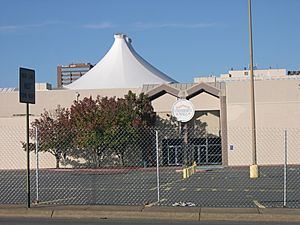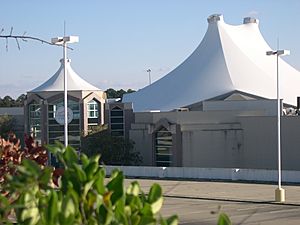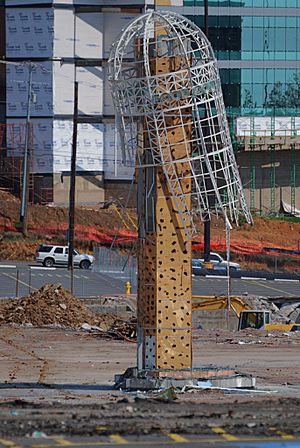University Mall (Little Rock, Arkansas) facts for kids

South entrance shortly before demolition
|
|
| Location | Little Rock, Arkansas, United States |
|---|---|
| Coordinates | 34°45′02″N 92°20′44″W / 34.750477°N 92.345604°W |
| Opening date | 1967 |
| Closing date | October 27, 2007 (demolished early 2008) |
| Developer | Melvin Simon & Associates (Simon Property Group) |
| Management | Strode Property Company |
| Owner | Jim Strode |
| No. of stores and services | 0 (70 at its peak) |
| No. of anchor tenants | 0 (3 at its peak) |
| Total retail floor area | 697,000 sq ft (64,800 m2). |
| No. of floors | 2 |
| Parking | 2,500 |
University Mall was a shopping mall in central Arkansas. It was open for about 40 years, from 1967 until 2007. When it closed, University Mall was the oldest indoor mall in the Little Rock area. It was located in Little Rock, near the University of Arkansas at Little Rock. The mall was managed by Indianapolis-based Simon Property Group.
The mall was very popular at first. However, new stores opened nearby, and people started shopping there instead. Big stores, called 'anchor stores,' like Montgomery Ward, closed down. This left much of the mall empty. Because fewer people were visiting and the building was getting old, the mall was sold in 2007. It was then torn down in early 2008. Before the main mall building was demolished, other smaller buildings nearby were taken down in December 2007. This included former auto centers for Montgomery Ward and JCPenney.
Contents
History of University Mall
How the Mall Started
The mall was built by Melvin Simon & Associates. This company is now known as Simon Property Group Inc. University Mall was their first project in Arkansas. However, they had already built about 40 other shopping centers in the United States.
The land for the mall belonged to a group of people who owned a company called Developers Inc. One of the owners was "Judge" William J. Smith. He was a well-known lawyer in Little Rock and an advisor to Governor Orval E. Faubus. Other owners included his family and John Cella, who owned Oaklawn Park, a horse racetrack. Developers Inc. closed down a few months before the mall was announced. The people who owned the company then became the owners of the mall land.
Smith said he got the idea for the mall in the 1950s. He was driving on University Avenue (then called Hayes Street) and thought it would be a good place for a mall. Over the next 15 years, he and John Cella bought about 28 acres (110,000 m2) of land for the mall. This even included moving a cemetery during construction. The land was then rented to Simon Property Group until 2026.
Plans for the mall were announced in 1965. Simon said the location had "the best potential he had ever seen" for a city the size of Little Rock. The mall was planned to have 565,000-square-foot (52,500 m2) of shopping space. It also had parking for 2,500 cars. When it first opened, it was a single-level building.
MM Cohn was the first big department store to sign a lease at the new mall. It was one of the main local department stores in downtown Little Rock. A few weeks later, Montgomery Ward and J.C. Penney also announced they would build their own stores there. Montgomery Ward built a 136,000-square-foot (12,600 m2) store. This was a big return for the national store in Little Rock. The J.C. Penney store was about 160,000 square feet (15,000 m2) and included a separate auto center. It became the largest department store in Arkansas.
Mall Upgrades in 1975 and 1987
In 1975, the mall got a new look and was renamed from "The Mall" to "University Mall." This was probably to make it different from the new McCain Mall that Simon was planning in North Little Rock. The mall reopened in March of that year. University Mall brought in many shoppers each year. It was also known for its holiday decorations and events. Many people, including older adults and heart patients, used the mall for walking.
In October 1987, Simon announced a big $15 million plan to expand and update University Mall. The work started in 1988 and finished about a year later. This expansion added 70,000 square feet (6,500 m2) of space to the mall. Many stores also spent money to remodel and expand their own spaces. MM Cohn updated its store and added a second-floor entrance to the mall. The J.C. Penney store also became larger.
This expansion added the mall's most unique feature: a tent-like roof made of Teflon. It was called a skylight because it let in so much natural light. The skylight was nine stories high. The main walkway was expanded to two levels. These levels were connected by escalators and an elevator. The new upper level had a walkway that looked down over the bottom level. It also had a 9,000-square-foot (840 m2) food court. A multi-level parking garage was also built on the north side of the mall.
A big four-day reopening celebration happened in November 1988. Corbin Bernsen from the TV show L.A. Law helped celebrate. An oversized electric switch was used to turn on the lights for the renovated mall. The reopening also featured a large carousel as a main attraction.
By this time, the mall had about 55 stores and hoped to have 70. The mall had about 697,000 square feet (64,800 m2) of space for stores. However, other new shopping centers were opening in the city. The Park Plaza shopping center, which was outdoors, was turned into an indoor mall. This new mall was directly across the street from University Mall. Park Plaza was almost 30 years old at the time. It was rebuilt and expanded to include a new Dillard's store. For the next ten years, University Mall still had many customers. But eventually, McCain Mall and Park Plaza became the most popular places to shop.
Mall's Decline
Problems for University Mall started in the 1980s. Stores began to worry about remodeling and advertising efforts. Osco Drug closed all its stores, including three in Little Rock, in 1997. In 2001, Montgomery Ward went out of business. This left a large, empty two-story building at University Mall. After this, fewer people came to the mall, and many stores started to leave.
In early 2001, Simon Property said University Mall was 95 percent full. But in April 2001, after Montgomery Ward left, a report said 40 percent of the mall was empty. By 2004, the landowners said the mall was not being taken care of. They claimed that Simon's neglect was causing stores to leave. Inspectors hired by the landowners said in 2005 that the empty Montgomery Ward store had puddles, moldy ceiling tiles, and dead pigeons.
In December 2006, Simon suggested tearing down the mall. They wanted to build a new mixed-use area with stores, offices, medical facilities, and homes. This new project would have included several buildings. However, these plans did not happen.
In June 2007, a judge ruled that Simon had to make over $7 million in repairs to the mall. But the lawsuit was stopped because the property was going to be sold.
Demolition of the Mall
In October 2007, the landowners sold the 27 acres (110,000 m2) of land under the mall. Dallas-based Strode Property Company bought the mall property for $21 million. Simon management told the remaining stores to leave the mall by October 27. Strode planned to tear down the mall and build a new outdoor shopping center called "Park Avenue." Strode wanted to create a "lifestyle center" that felt like a main street. The only parts of the old University Mall that might be kept were the parking garage and the Montgomery Ward basement.
Saturday, October 27, 2007, was the last day to shop at the mall. Only two local stores, Paul's Shoes and Nouri Dress Shop, were still open. Both businesses moved to a new shopping center called Shackleford Crossings. After all the stores left, the entire University Mall property was surrounded by fences. Demolition of the smaller buildings began in December 2007. The main mall building started to be torn down in January 2008 and was finished by March. Strode expected the new Park Avenue development to open in 2010.
Today, much of where the mall used to be is now a parking area for the stores in Park Avenue. The Target store and other businesses in Park Avenue are located where University Mall's parking lots used to be.
Images for kids






